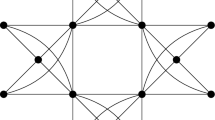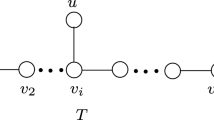Abstract
The Plotkin bound and the quadratic bound for codes and (t, m, s)-nets can be obtained from the linear programming bound using certain linear and quadratic polynomials, respectively. We extend this approach by considering cubic and higher degree polynomials to find new explicit bounds as well as new non-existence results for codes and (t, m, s)-nets.
Similar content being viewed by others
References
Bierbrauer J.: A direct approach to linear programming bounds for codes and tms-nets. Des. Codes Cryptogr. 42(2), 127–143 (2007)
Delsarte P.: An algebraic approach to the association schemes of coding theory. Philips Res. Rep. Suppl. (10), 1–97 (1973).
Hedayat A.S., Sloane N.J.A., Stufken J.: Orthogonal Arrays. Springer Series in Statistics. Springer-Verlag, New York (1999)
Lawrence K.M.: A combinatorial characterization of (t, m, s)-nets in base b. J. Comb. Des. 4(4), 275–293 (1996)
MacWilliams F.J., Sloane N.J.A.: The Theory of Error-Correcting Codes. North-Holland Publishing Co., Amsterdam (1977)
Martin W.J., Stinson D.R.: Association schemes for ordered orthogonal arrays and (T, M, S)-nets. Canad. J. Math. 51(2), 326–346 (1999)
Martin W.J., Visentin T.I.: A dual Plotkin bound for (T, M, S)-nets. IEEE Trans. Inform. Theory 53(1), 411–415 (2007)
Mullen G.L., Schmid W.Ch.: An equivalence between (t, m, s)-nets and strongly orthogonal hypercubes. J. Comb. Theory Ser. A 76(1), 164–174 (1996)
Niederreiter H.: Low-discrepancy point sets. Monatsh. Math. 102(2), 155–167 (1986)
Niederreiter H.: Point sets and sequences with small discrepancy. Monatsh. Math. 104(4), 273–337 (1987)
Niederreiter H.: Orthogonal arrays and other combinatorial aspects in the theory of uniform point distributions in unit cubes. Discrete Math. 106/107, 361–367 (1992)
Rosenbloom M.Y., Tsfasman M.A.: Codes for the m-metric. Probl. Inform. Transm. 33(1), 55–63 (1997)
Schürer R., Schmid W.Ch.: MinT: a database for optimal net parameters. In: Monte Carlo and Quasi-Monte Carlo Methods 2004, pp. 457–469. Springer, Berlin (2006).
Sobol′ I.M.: Distribution of points in a cube and approximate evaluation of integrals. Z̆. Vyčisl. Mat. i Mat. Fiz. 7, 784–802 (1967)
Author information
Authors and Affiliations
Corresponding author
Additional information
Communicated by Juergen Bierbrauer.
Rights and permissions
About this article
Cite this article
Trinker, H. Cubic and higher degree bounds for codes and (t, m, s)-nets. Des. Codes Cryptogr. 60, 101–121 (2011). https://doi.org/10.1007/s10623-010-9420-x
Received:
Revised:
Accepted:
Published:
Issue Date:
DOI: https://doi.org/10.1007/s10623-010-9420-x
Keywords
- Cubic bound for codes and (t, m, s)-nets
- Polynomial bound for codes and (t, m, s)-nets
- Linear programming bound
- Plotkin bound
- Quadratic bound




